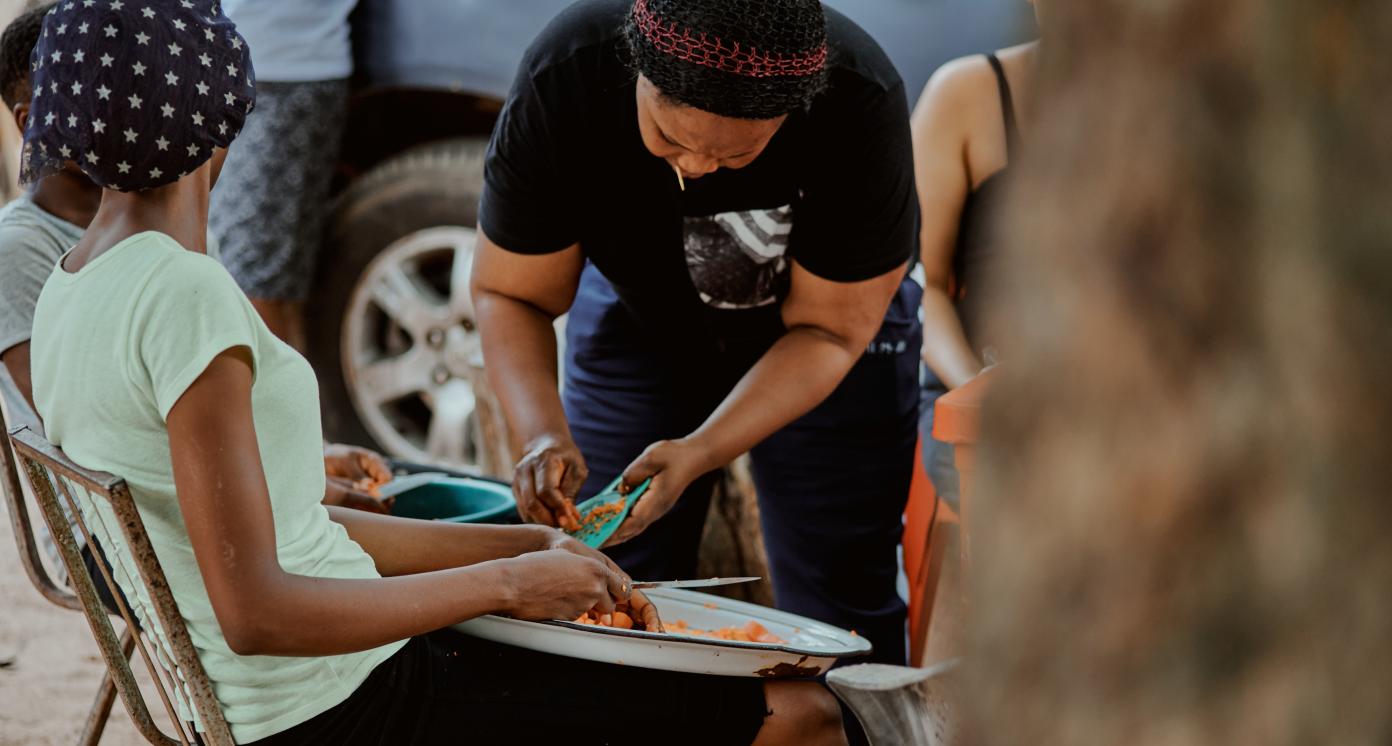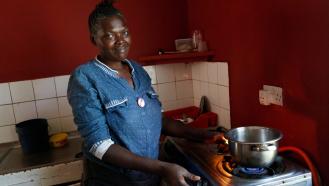Improved cooking stoves






Business Model Description
Manufacture and distribute energy efficient cooking stoves for low income earners and rural communities.
Expected Impact
Reduce fuel emissions from burning wood and contribute to air quality and health outcomes.
How is this information gathered?
Investment opportunities with potential to contribute to sustainable development are based on country-level SDG Investor Maps.
Disclaimer
UNDP, the Private Finance for the SDGs, and their affiliates (collectively “UNDP”) do not seek or solicit investment for programmes, projects, or opportunities described on this site (collectively “Programmes”) or any other Programmes, and nothing on this page should constitute a solicitation for investment. The actors listed on this site are not partners of UNDP, and their inclusion should not be construed as an endorsement or recommendation by UNDP for any relationship or investment.
The descriptions on this page are provided for informational purposes only. Only companies and enterprises that appear under the case study tab have been validated and vetted through UNDP programmes such as the Growth Stage Impact Ventures (GSIV), Business Call to Action (BCtA), or through other UN agencies. Even then, under no circumstances should their appearance on this website be construed as an endorsement for any relationship or investment. UNDP assumes no liability for investment losses directly or indirectly resulting from recommendations made, implied, or inferred by its research. Likewise, UNDP assumes no claim to investment gains directly or indirectly resulting from trading profits, investment management, or advisory fees obtained by following investment recommendations made, implied, or inferred by its research.
Investment involves risk, and all investments should be made with the supervision of a professional investment manager or advisor. The materials on the website are not an offer to sell or a solicitation of an offer to buy any investment, security, or commodity, nor shall any security be offered or sold to any person, in any jurisdiction in which such offer would be unlawful under the securities laws of such jurisdiction.
Case Studies
Country & Regions
- Nigeria: North Central (Middle Belt)
- Nigeria: South West
- Nigeria: South South (Niger Delta)
Sector Classification
Consumer Goods
Development need
The manufacturing sector accounted for 9.65% of real gross domestic product (GDP) in Q1, 2020. Between 2010 and 2015, the sector grew at an average annual growth rate of 13.3%.(1) However, the sector remains small compared with countries such as South Africa (13%), Morocco (18%), Mexico (18%) and Indonesia (21%).(2)
Policy priority
Nigeria is seeking to improve performance by developing Special Economic Zones (SEZs) to attract investment in manufacturing consumer goods. It aims to draw investment away from economies where the labor cost advantage is declining, and to re-energize industries in Nigeria.
Gender inequalities and marginalization issues
Micro, small and medium enterprises (MSMEs) play a critical role in the fast moving consumer good (FMCG) supply chain as distributors, ensuring products reach Nigeria’s growing consumer market. Women-owned and led businesses represent 13.2% of these MSMEs.(19)
Investment opportunities introduction
Population growth projections indicate Nigeria is set to reach 300 million people by 2030 and 400 million by 2050, coupled with an expanding middle class.(3) This suggests strong growth potential for consumer goods, and underscores the fundamental attractiveness of the Nigerian market.
Key bottlenecks introduction
Nigeria’s manufacturing sector has been challenged by stagnant economic conditions, insufficient infrastructure and a lack of access to raw materials, accompanied by important inefficiencies and low competitiveness.(4)
Consumer Goods Retail
Policy priority
To effectively address energy needs and attract relevant investors for low carbon development, Nigeria has developed a Clean Technology Fund (CTF) investment plan of USD250 million. This fund covers a range of projects across various sectors including energy efficiency, renewable energy and transport.(5)
Gender inequalities and marginalization issues
Cooking habits are generally uniform across the country. While urban households have adopted gas, rural households still rely on fuel wood and kerosene.
Multiline and Specialty Retailers and Distributors
Pipeline Opportunity
Improved cooking stoves
Manufacture and distribute energy efficient cooking stoves for low income earners and rural communities.
Business Case
Market Size and Environment
94% of Nigerians have been using dirty fuels for cooking.
The proportion of Nigeria's population who mainly use dirty fuels such as wood, charcoal, coal and kerosene for cooking is very high, reaching 94% in 2016.(7)
Indicative Return
5% - 10%
The estimated return rate for investors is 9.6% - 11.6%. This rate is a benchmark calculated as a cost of equity, reflecting an average return required by investors active in the subsector.(8)
Investment Timeframe
Short Term (0–5 years)
Based on studied benchmark projects, investing in large-scale energy efficient cook stoves takes 1 - 6 months. Cashflow should be generated within 2 years.
Ticket Size
USD 500,000 - USD 1 million
Market Risks & Scale Obstacles
Capital - Limited Investor Interest
Business - Supply Chain Constraints
Impact Case
Sustainable Development Need
Cooking accounts for 91% of total domestic energy consumption.(9) The proportion of Nigeria's population who mainly use dirty fuels such as wood, charcoal, coal and kerosene for cooking is very high, reaching 94% in 2016.(7)
Wood is the most widely used cooking fuel. An estimated 120 million Nigerians are at risk of illness and deaths from exposure to cooking smoke.(9) In 2017, the observed number of deaths attributable to household air pollution was 64,000.(10)
With modern fuel penetration in Nigeria less than 1%, wood and charcoal used in open fires are the main cause of indoor pollution, which imposes a significant health burden across the country. 3.8% of national burden of disease is attributed to solid fuel use.(11)
A business-as usual-scenario places enormous pressure on biomass reserves. Biomass consumption is expected to reach 437 million tons by 2030 based on current consumption trends.(12)
Gender & Marginalisation
Cooking habits are generally uniform across the country. While urban households have adopted gas, rural households still rely on fuel wood and kerosene.
Expected Development Outcome
Investments could reduce the use of fuel wood and indoor pollution, save time and resources, and increase health and wellbeing of households.
Gender & Marginalisation
By promoting healthy and sustainable cooking practices, investments may contribute to positive health outcomes especially for women living in rural areas who do most cooking.
Primary SDGs addressed

7.1.2 Proportion of population with primary reliance on clean fuels and technology
7.b.1 Installed renewable energy-generating capacity in developing countries (in watts per capita)
28.2% in 2015. (16)
Foreign direct investment (FDI), official development assistance and South-South Cooperation as a proportion of total domestic budget has been growing since 2016. It rose from 6.9% in 2016 to 7.6% in 2017 and to 8.4% in 2018. Foreign direct investment (FDI) is 0.6% of gross domestic product (GDP).(16)
Nigeria is committed to implement its Natural Gas Expansion Programme within 12 months through its Inter-Ministerial Committee on liquified petroleum gas (LPG). The aim is to create 1 million jobs by converting 30 million homes from dirty fuels (kerosene, charcoal and diesel) to LPG.(17)
N/A

8.2.1 Annual growth rate of real GDP per employed person
4.68% in 2015.(17)
Sustain per capita economic growth in accordance with national circumstances and, in particular, at least 7% gross domestic product (GDP) growth per year.(18)

9.2.1 Manufacturing value added as a proportion of GDP and per capita
9.2.2 Manufacturing employment as a proportion of total employment
Manufacturing value added as a proportion of gross domestic product (GDP): 9.43 %. Manufacturing value added as a proportion of per capital: 0.03%.(16)
0.31% in 2015.(16)
The Central Bank’s NGN 3.5 trillion stimulus package includes a credit line of NGN 1 trillion to boost manufacturing and import substitution.(18)
The Central Bank’s NGN 3.5 trillion stimulus package includes credit line of NGN 1 trillion to boost manufacturing and import substitution.(18)
Secondary SDGs addressed



Directly impacted stakeholders
People
Corporates
Indirectly impacted stakeholders
People
Outcome Risks
Improper fuel loading and lack of maintenance can lead to efficiency losses.
Impact Risks
Alignment risk: Impact is not locked into the entity’s (i.e. the enterprise, fund, investee or issuer) business model given the high engagement of non-profit organizations in this area.
Drop-off risk: Positive impact does not endure or negative impact is no longer mitigated
Unexpected impact risk: Increased manufacturing may add to environmental pollution.
Impact Classification
What
The outcome is likely to be positive because investments in clean energy solutions will ultimately reduce health risks associated with continued use of fuel wood.
Who
Local households and communities with lack of access to clean energy solutions.
Risk
Low consumer buy-in
Impact Thesis
Reduce fuel emissions from burning wood and contribute to air quality and health outcomes.
Enabling Environment
Policy Environment
The Nigerian Alliance for Clean Cookstove (an organization created by both the government and private sector) is supporting the transformation. The leading support programme aimed to install 10 million clean and efficient cookstoves by 2020.(12)
National Renewable Energy and Energy Efficiency Policy 2015: This policy promotes the adoption of energy saving appliances and devices through a nationwide energy campaign and training sessions.(13)
National Renewable Energy and Energy Efficiency Policy 2015: It also provides incentives for retailers and importers of energy efficient products and promotes local manufacturing.(13)
National Energy Policy 2003: This policy promotes the use of alternatives to fuel wood, promotes improved efficiency in use of fuel wood and de-emphasizes fuel wood in nation’s energy mix.(7)
Financial Environment
Financial incentives: Credit is available for domestic and foreign investors in clean energy initiatives. The strong progress of the Kyoto Clean Development Mechanism (CDM) for clean cookstove programs in Nigeria has created a favorable carbon financing environment for future project developers.(11)
Regulatory Environment
The Nigerian Alliance for Clean Cookstoves (NACC), the Standards Organization of Nigeria (SON) and other key stakeholders approved new standards for improved cook stoves in Nigeria.(14)
Marketplace Participants
Private Sector
Novastar Ventures, C-Quest Capital, StoveTec, DARE & BIA
Multilaterals
African Development Bank (AfDB), German Corporation for International Cooperation (GIZ), UN Habitat
Non-Profit
Happy Cook Stove, Clean Cooking Alliance
Target Locations
Nigeria: North Central (Middle Belt)
Nigeria: South West
Nigeria: South South (Niger Delta)
References
- (1) Nigerian Bureau of Statistics (2020). Nigerian Gross Domestic Product Report Q1 2020.
- (2) Federal Republic of Nigeria (2017). Economic Recovery and Growth Plan 2017 - 2020. Abuja: Ministry of Budget and National Planning.
- (3) Oxford Business Group (2021). Nigerian domestic market supports producers of fast-moving consumer goods. https://oxfordbusinessgroup.com/analysis/domestic-moves-major-manufacturers-fast-moving-consumer-goods-have-been-supported-expanding-domestic
- (4) Odey, J., Saliu, H., Achukwu, E.O. and Olashina, O. (2018). Challenges and opportunities in the Nigeria textile sector.
- (5) Clean Technology Fund (2014). Investment Plan For Nigeria.
- (6) World Bank Database.
- (7) National Energy Policy 2003.
- (8) PwC analysis based on Prof. A. Damodaran data, 2020.
- (9) Jewitt, S., Atagher, P. and Clifford, M. (2020). 'We cannot stop cooking': Stove stacking, seasonality and the risky practices of household cookstove transitions In Nigeria. https://www.sciencedirect.com/science/article/pii/S2214629619304700?via%3Dihub
- (10) Clean Cooking Alliance (2020). Nigeria. https://www.cleancookingalliance.org/country-profiles/focus-countries/3-nigeria.html#:~:text=Exposure%20to%20smoke%20from%20polluting,deaths%20in%20Nigeria%2C%20every%20year.
- (11) Accenture Global Alliance for Clean Cookstoves (2011). Nigeria market assessment sector mapping 2011.
- (12) Gujba, H., Mulugetta, Y. and Azapagic, A. 'The household cooking sector in Nigeria: environmental and economic sustainability assessment'. Resources 2015, 4, 412-433.
- (13) National Renewable Energy and Energy Efficiency Policy (NREEEP) 2015.
- (14) Standards Organisation of Nigeria (2017). Nigerian Alliance for Clean Cookstoves and SON agree standards for improved biomass cookstoves. https://son.gov.ng/nigerian-alliance-for-clean-cook-stoves-and-son-agree-standards-for-improved-biomass-cook-stoves
- (15) Clean Cooking Alliance (2021). Wise Ecostove Nigeria Limited. https://www.cleancookingalliance.org/partners/item/999/2561
- (16) Federal Republic of Nigeria (2017). Implementation of the SDGs: a national voluntary review. https://sustainabledevelopment.un.org/content/documents/16029Nigeria.pdf
- (17) Federal Republic of Nigeria (2020). Nigeria Economic Sustainability Plan (2020). https://media.premiumtimesng.com/wp-content/files/2020/06/ESC-Plan-compressed-1.pdf
- (18) Federal Republic of Nigeria (2020). Integration of the SDGs into National Development Planning: A Second Voluntary National Review (2020). https://sustainabledevelopment.un.org/content/documents/26309VNR_2020_Nigeria_Report.pdf
- (19) International Finance Corporation. Case study: women entrepreneurs find business opportunities in Nigeria’s fastmoving consumer goods sector. https://www.ifc.org/wps/wcm/connect/7386ef01-05fe-4a26-8909-ead2143c6863/IFC-Daraju+gender+case+study+2019.pdf?MOD=AJPERES&CVID=mSnCvut

















